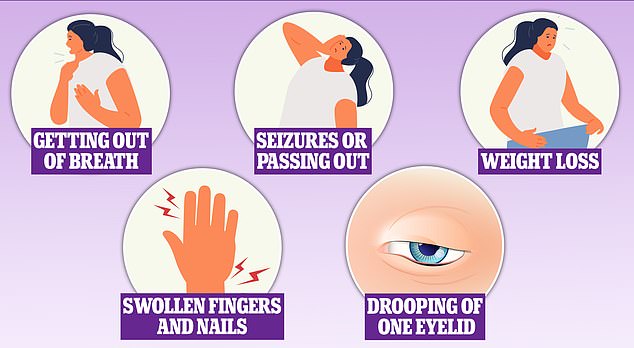Five little-known warning signs of lung cancer revealed after death of Massive Attack star Angelo Bruschini
Massive Attack guitarist Angelo Bruschini has died after a battle with lung cancer, the band announced today.
The Bristol-born musician revealed in July that he had been diagnosed with the fatal disease and had had ‘an amazing life’.
The band, which Angelo joined in 1995, wrote on X, formerly Twitter, that he was an “exceptionally brilliant and eccentric talent.”
Lung cancer, which kills around 35,000 people in Britain and 120,000 in the US every year, is the second most common form of cancer worldwide.
Yet many people are not aware of all the symptoms. MailOnline reveals the warning signs to look out for.

Guitarist Angelo Bruschini has died after a battle with lung cancer, the band announced on Tuesday (pictured in June 2014)

Persistent coughing, shortness of breath and fainting can all be symptoms of lung cancer, according to Cancer Research
Getting out of breath
There are often no symptoms in the early stages of lung cancer.
But many will become breathless and develop a persistent cough that won’t go away, the NHS says.
If you feel exhausted while doing things that normally wouldn’t be a problem, this is a sign to see your doctor, he advises.
This symptom may also be accompanied by coughing up blood and pain in the shoulder or chest when coughing.
Lung cancer is rare in people under 40 and, according to the NHS, more than four in 10 people diagnosed in Britain are aged 75 or over.
It adds that smoking is the most common cause of lung cancer.
Changes in nail shape
Nails that appear wider, spongy, or swollen could be a signal of lung cancer.
This symptom is called clubbing.
The nails may appear to ‘float’ rather than stick to the nail bed and form a sharper angle with the cuticle.
Clubbing can also cause the end of the finger to look large and red and the nail to curve downward so that it resembles the rounded part of an inverted spoon.
The symptoms are caused by hypertrophic pulmonary osteoarthropathy (HPOA) – a condition that causes inflammation in the bones and joints and affects some people with cancer.
However, not everyone with lung cancer will develop this symptom and it is more common in people with non-small cell lung cancer, says Cancer Research.
Seizures or fainting
Dizziness and fainting can be signs of lung cancer.
Although rare, some lung cancer patients develop a condition called paraneoplastic syndrome in addition to their cancer.
It is caused by tumors that release hormones into the bloodstream that cause the body’s organs and systems to behave abnormally.
This can lead to symptoms that appear unrelated to lung cancer.
These include headache, vomiting, confusion, feeling tired, muscle weakness, seizures, fainting, dizziness and constipation.
Paraneoplastic syndrome is rare, but more common in people with small cell lung cancer.

Massive Attack shared a tribute to him on social media on Tuesday

Lunchtime cancer, while not the most common form of the disease, is one of the biggest cancer killers in Britain with a survival rate of just 10 per cent.
Drooping of one eyelid
A rare form of lung cancer that grows at the top of the organ can cause one eyelid to droop, experts say.
Pancoast tumors, which account for less than five percent of lung cancer cases, can also cause one pupil to become smaller.
According to Cancer Research, it can also stop sweating on one side of the face.
Shoulder pain or pain going up and down the arm, neck and head are more common symptoms of this form of cancer, according to the charity.
Lose weight
About 60 percent of people with lung cancer have significant weight loss by the time of their diagnosis, Cancer Research says.
This may be because lung cancer causes a loss of appetite.
However, some people lose weight even when they eat normally.
This is called cachexia, where your body doesn’t absorb all the fat, protein, and carbohydrates from your food and burns calories faster than normal.
Scientists say cancer releases chemicals into the blood that contribute to the loss of fat and muscle.
